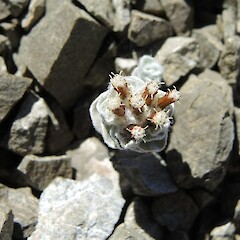Rachelia glaria
Synonyms
None (described in 1997)
Family
Asteraceae
Flora category
Vascular – Native
Endemic taxon
Yes
Endemic genus
Yes
Endemic family
No
Structural class
Herbs - Dicotyledonous composites
Chromosome number
2n = 28
Current conservation status
The conservation status of all known New Zealand vascular plant taxa at the rank of species and below were reassessed in 2017 using the New Zealand Threat Classification System (NZTCS) – more information about this can be found on the NZTCS website. This report includes a statistical summary and brief notes on changes since 2012 and replaces all previous NZTCS lists for vascular plants.
Please note, threat classifications are often suggested by authors when publications fall between NZTCS assessment periods – an interim threat classification status has not been assessed by the NZTCS panel.
- Conservation status of New Zealand indigenous vascular plants, 2017 . 2018. Peter J. de Lange, Jeremy R. Rolfe, John W. Barkla, Shannel P. Courtney, Paul D. Champion, Leon R. Perrie, Sarah M. Beadel, Kerry A. Ford, Ilse Breitwieser, Ines Schönberger, Rowan Hindmarsh-Walls, Peter B. Heenan and Kate Ladley. Department of Conservation. Source: NZTCS and licensed by DOC for reuse under the Creative Commons Attribution 4.0 International licence.
2017 | At Risk – Naturally Uncommon | Qualifiers: DP, RR, Sp
Previous conservation statuses
2012 | Threatened – Nationally Vulnerable | Qualifiers: RR, Sp
2009 | At Risk – Declining | Qualifiers: RR, Sp
2004 | Range Restricted
Distribution
Endemic. New Zealand: South Island (eastern Marlborough on the ranges at the head waters of the Awatere River and at Mt Terako, northern Canterbury).
Habitat
Alpine. A species of dry, shingly, non-glaciated mountains, where it appears to be confined to fine argillite lenses within mobile scree.
Detailed description
Tufted, silver-grey perennial herb with widely spaced groups of 1–10 upright shoots, 10–30 × 10 mm in diameter, produced from long, slender, branched rhizomes. Aerial stems sparingly and shortly branched or sometimes unbranched, entirely obscured by leaves. Leaves imbricate, with leaf base clasping stem and with lamina spreading at an angle of c. 45°, broadly obovate-spathulate, 6.9–9.7 × 4.6–8.5 mm wide, densely lanate all over both surfaces; lamina 4.2–6.5 mm long, widest in upper ⅓, slightly folded along midrib; apex truncate, not mucronate; leaf hairs loosely appressed, ascending, matted, crinkled at free ends; base 2.5–4.4 mm long, widest in upper ⅓, frequently pink-tinged, with 3 strong veins. Capitula 2–9 per stem, one terminal and associated with 2 leaves, the others usually sessile in the axils of the upper leaves, rarely terminal on very short axillary shoots with no stem elongation and with 2 small leaves; capitula cluster, including leaves, 15 mm in diameter. Capitulum 7.7–9.0 × 1.7–3.0 mm. Involucral bracts 14–15, outermost bracts 5–7 × 2.6 mm including margins; innermost bracts narrowly rhombic, 7.1–7.6 × 2.2 mm including margins; lamina 3.3 × 1.0 mm, pale brown near base, bright brown above; apex acute; margins broad, hyaline; stereome 3.8–4.7 mm long, pale green, not fenestrated, vein extending into lamina. Receptacle 0.5–1.0 mm in diameter, high and rounded with florets attached to the sides as well as the top. Florets 7–11, all of the female and some of the hermaphrodite florets arranged in a ring and surrounding the remaining hermaphrodite florets. Female florets 3–5; corolla 4.2 mm long, red below lobes, otherwise translucent pale green; tube 0.15 mm wide, broadening to 0.3 mm at base. Hermaphrodite florets 3–6; corolla 4.6 mm long, broadening only slightly above, red below lobes; tube 0.4 mm wide; lobes 0.6 mm long, translucent pale green with a small variable amount of red pigment, not spreading, margins papillose, veins sometimes extending to tip, but variable in a single floret; biseriate capitate hairs on lobes and a few on upper part of tube, a few simple long-tailed hairs on lobes. Anthers far exserted from corolla; apical anther appendage flat, tapering; anther tails far exceeding filament collar. Mature cypsela 1.5–1.9 × 0.8 mm, ridged, reddish or brown; papillate. Pappus hairs 5.3–5.6 mm long; shaft 40–55 μm wide.
Similar taxa
Recognised by its distinctive inflorescence with the capitula in a dense cluster at the end of the stem and each subtended by a leaf. Similar to Haastia sinclairii Hook.f. from which it is distinguished by its truncate leaves and smaller shoot and leaf size, and from Leucogenes grandiceps (Hook.f.) Beauverd by its short aerial stems and larger leaf size.
Flowering
December to January
Flower colours
Green, Red/Pink
Fruiting
February to March
Propagation technique
Extremely difficult to grow and it should not be removed from the wild.
Threats
A naturally uncommon plant of fine, mobile, scree where it is restricted is narrow lenses of argillite. Rachelia is especially vulnerable to trampling and some accessible populations have been damaged by plant collectors. In recent years at least one well known population as died out for reasons that are as yet unclear. Rachelia may be more threatened than has previously been believed.
Where To Buy
Not commercially available
Attribution
Description modified from Ward et al. (1997).
References and further reading
Ward JM, Breitwieser I, Lovis JD. 1997. Rachelia glaria (Compositae), a new genus and species from the South Island of New Zealand. New Zealand Journal of Botany 35(2): 145–154. https://doi.org/10.1080/0028825X.1997.10414150.


